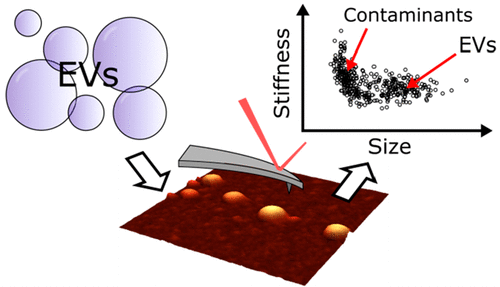当前位置:
X-MOL 学术
›
Anal. Chem.
›
论文详情
Our official English website, www.x-mol.net, welcomes your
feedback! (Note: you will need to create a separate account there.)
AFM-Based High-Throughput Nanomechanical Screening of Single Extracellular Vesicles.
Analytical Chemistry ( IF 6.7 ) Pub Date : 2020-07-07 , DOI: 10.1021/acs.analchem.9b05716 Andrea Ridolfi 1, 2, 3 , Marco Brucale 1, 2 , Costanza Montis 1, 3 , Lucrezia Caselli 3 , Lucia Paolini 1, 4 , Anne Borup 5 , Anders T Boysen 5 , Francesca Loria 6 , Martijn J C van Herwijnen 7 , Marije Kleinjan 7 , Peter Nejsum 5 , Natasa Zarovni 6 , Marca H M Wauben 7 , Debora Berti 1, 3 , Paolo Bergese 1, 4 , Francesco Valle 1, 2
Analytical Chemistry ( IF 6.7 ) Pub Date : 2020-07-07 , DOI: 10.1021/acs.analchem.9b05716 Andrea Ridolfi 1, 2, 3 , Marco Brucale 1, 2 , Costanza Montis 1, 3 , Lucrezia Caselli 3 , Lucia Paolini 1, 4 , Anne Borup 5 , Anders T Boysen 5 , Francesca Loria 6 , Martijn J C van Herwijnen 7 , Marije Kleinjan 7 , Peter Nejsum 5 , Natasa Zarovni 6 , Marca H M Wauben 7 , Debora Berti 1, 3 , Paolo Bergese 1, 4 , Francesco Valle 1, 2
Affiliation

|
The mechanical properties of extracellular vesicles (EVs) are known to influence their biological function, in terms of, e.g., cellular adhesion, endo/exocytosis, cellular uptake, and mechanosensing. EVs have a characteristic nanomechanical response which can be probed via force spectroscopy (FS) and exploited to single them out from nonvesicular contaminants or to discriminate between subtypes. However, measuring the nanomechanical characteristics of individual EVs via FS is a labor-intensive and time-consuming task, usually limiting this approach to specialists. Herein, we describe a simple atomic force microscopy based experimental procedure for the simultaneous nanomechanical and morphological analysis of several hundred individual nanosized EVs within the hour time scale, using basic AFM equipment and skills and only needing freely available software for data analysis. This procedure yields a “nanomechanical snapshot” of an EV sample which can be used to discriminate between subpopulations of vesicular and nonvesicular objects in the same sample and between populations of vesicles with similar sizes but different mechanical characteristics. We demonstrate the applicability of the proposed approach to EVs obtained from three very different sources (human colorectal carcinoma cell culture, raw bovine milk, and Ascaris suum nematode excretions), recovering size and stiffness distributions of individual vesicles in a sample. EV stiffness values measured with our high-throughput method are in very good quantitative accord with values obtained by FS techniques which measure EVs one at a time. We show how our procedure can detect EV samples contamination by nonvesicular aggregates and how it can quickly attest the presence of EVs even in samples for which no established assays and/or commercial kits are available (e.g., Ascaris EVs), thus making it a valuable tool for the rapid assessment of EV samples during the development of isolation/enrichment protocols by EV researchers. As a side observation, we show that all measured EVs have a strikingly similar stiffness, further reinforcing the hypothesis that their mechanical characteristics could have a functional role.
中文翻译:

基于AFM的单个细胞外囊的高通量纳米力学筛选。
已知细胞外囊泡(EVs)的机械性质会影响其生物学功能,例如在细胞粘附,内吞/胞吐作用,细胞摄取和机械传感方面。电动汽车具有特征性的纳米机械响应,可以通过力谱(FS)进行探测,并可以将其从非囊泡污染物中识别出来,或区分亚型。但是,通过FS测量单个电动汽车的纳米机械特性是一项劳动强度大且耗时的任务,通常将这种方法限制于专家。在这里,我们描述了一个简单的基于原子力显微镜的实验程序,用于在小时时间内对几百个单独的纳米级电动汽车进行纳米力学和形态学分析,使用基本的AFM设备和技能,只需要免费提供的软件即可进行数据分析。此过程可产生EV样品的“纳米机械快照”,可用于区分同一样品中囊泡和非囊泡对象的亚群,以及大小相似但机械特性不同的囊泡群体。我们证明了从三种非常不同的来源(人结肠直肠癌细胞培养,生牛乳和scar虫线虫排泄物),恢复样品中单个囊泡的大小和刚度分布。用我们的高通量方法测得的EV刚度值与通过一次测量EV的FS技术获得的值在定量上非常一致。我们展示了我们的程序如何检测非水疱聚集体对EV样品的污染,以及如何快速检测EV的存在,即使在尚无确定的测定和/或商业试剂盒的样品中也是如此(例如,A虫病)电动汽车),因此使其成为在电动汽车研究人员开发隔离/富集方案期间快速评估电动汽车样品的有价值的工具。作为侧面观察,我们显示所有测得的电动汽车都具有惊人相似的刚度,进一步强化了其机械特性可能具有功能性作用的假设。
更新日期:2020-08-04
中文翻译:

基于AFM的单个细胞外囊的高通量纳米力学筛选。
已知细胞外囊泡(EVs)的机械性质会影响其生物学功能,例如在细胞粘附,内吞/胞吐作用,细胞摄取和机械传感方面。电动汽车具有特征性的纳米机械响应,可以通过力谱(FS)进行探测,并可以将其从非囊泡污染物中识别出来,或区分亚型。但是,通过FS测量单个电动汽车的纳米机械特性是一项劳动强度大且耗时的任务,通常将这种方法限制于专家。在这里,我们描述了一个简单的基于原子力显微镜的实验程序,用于在小时时间内对几百个单独的纳米级电动汽车进行纳米力学和形态学分析,使用基本的AFM设备和技能,只需要免费提供的软件即可进行数据分析。此过程可产生EV样品的“纳米机械快照”,可用于区分同一样品中囊泡和非囊泡对象的亚群,以及大小相似但机械特性不同的囊泡群体。我们证明了从三种非常不同的来源(人结肠直肠癌细胞培养,生牛乳和scar虫线虫排泄物),恢复样品中单个囊泡的大小和刚度分布。用我们的高通量方法测得的EV刚度值与通过一次测量EV的FS技术获得的值在定量上非常一致。我们展示了我们的程序如何检测非水疱聚集体对EV样品的污染,以及如何快速检测EV的存在,即使在尚无确定的测定和/或商业试剂盒的样品中也是如此(例如,A虫病)电动汽车),因此使其成为在电动汽车研究人员开发隔离/富集方案期间快速评估电动汽车样品的有价值的工具。作为侧面观察,我们显示所有测得的电动汽车都具有惊人相似的刚度,进一步强化了其机械特性可能具有功能性作用的假设。









































 京公网安备 11010802027423号
京公网安备 11010802027423号